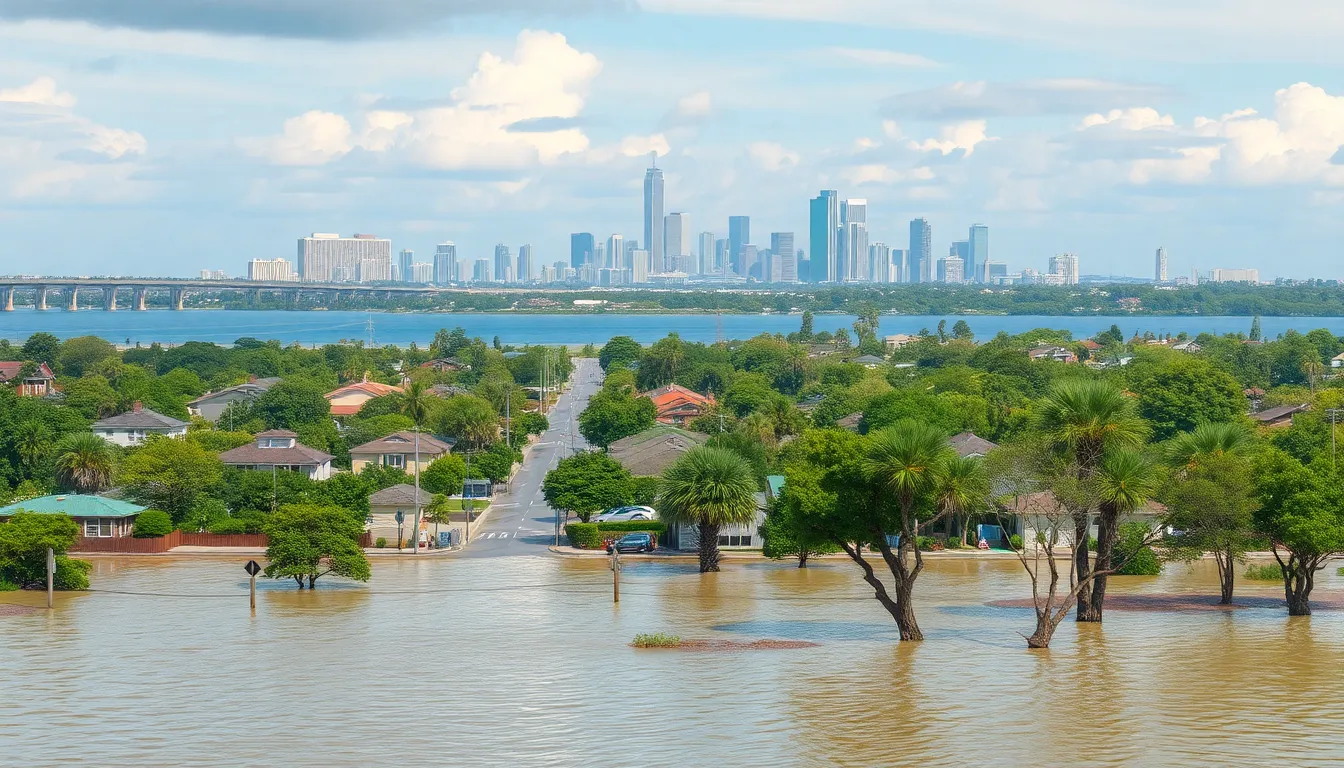Global warming isn’t just a hot topic; it’s literally heating up the planet. As temperatures rise, the effects are becoming impossible to ignore. From melting ice caps to more intense hurricanes, Mother Nature’s throwing a tantrum that even the best climate scientists can’t calm down.
Table of Contents
ToggleOverview of Global Warming Effects
Global warming leads to significant environmental changes. Rising temperatures cause polar ice caps to melt, contributing to higher sea levels. Increased sea levels threaten coastal communities and ecosystems. Severe weather patterns result from these temperature shifts, leading to hurricanes and floods becoming more intense and frequent.
Biodiversity suffers as habitats change or disappear. Many plant and animal species face extinction due to altered climates. Ocean acidification, a direct consequence of increased carbon dioxide absorption, disrupts marine life, particularly coral reefs.
Human health also deteriorates as heat waves become common. Vulnerable populations experience higher risks of heat-related illnesses. Air quality worsens due to increased pollution levels, leading to respiratory issues.
Agriculture is impacted significantly. Crop yields fluctuate as weather patterns become unpredictable, jeopardizing food security. Water scarcity arises in several regions, affecting both agriculture and drinking supplies.
Economic repercussions emerge when natural disasters damage infrastructure. Insurance costs rise as claims from extreme weather incidents increase. Communities must adapt to these new realities, creating challenges for both urban and rural areas.
Understanding these effects is crucial for developing strategies to mitigate global warming. Engaging with this topic enhances awareness and fosters collective action toward sustainable solutions.
Environmental Impacts

Global warming triggers significant environmental changes that jeopardize ecosystems and human life. Notably, rising sea levels pose a major threat.
Rising Sea Levels
Rising sea levels, driven by melting glaciers and thermal expansion of water, endanger coastal cities. By 2100, projections estimate an increase of up to 3 feet in sea levels. As a result, many low-lying areas face increased flooding risks and coastal erosion. Coastal ecosystems, such as mangroves and wetlands, play crucial roles, but they also suffer from submergence and salinization. Economic impacts emerge too, with property damage costs escalating. Communities must prepare for displacement and infrastructure loss due to persistent flooding.
Changes in Weather Patterns
Changes in weather patterns result from the warming of the Earth. Increased global temperatures fuel more intense storms, hurricanes, and floods. Research indicates that severe weather events have become 10% more frequent in the past few decades. Droughts also occur more often, affecting water security and agriculture. Unpredictable seasons disrupt traditional farming practices, leading to food shortages. Human safety depends on addressing these variations through adaptation strategies. Enhanced infrastructure and emergency preparedness directly relate to mitigating risks.
Economic Consequences
Climate change brings profound economic consequences that touch many sectors, particularly agriculture and natural resources.
Impact on Agriculture
Agricultural output faces significant risk due to climate shifts. Unpredictable weather patterns result in an up to 20% reduction in crop yields in vulnerable regions. Increased temperatures cause heat stress in plants and livestock, leading to lower productivity. Droughts and excessive rainfall disrupt planting schedules, complicating farmers’ ability to manage their crops. Additionally, pests thrive in warmer climates, further threatening food security. Supply chain disruptions arise from less reliable harvests, driving food prices higher and impacting low-income families the most.
Effect on Natural Resources
Natural resources experience increased pressure from climate change. Water scarcity dramatically affects both urban and rural areas, creating conflict over limited supplies. Rising temperatures lead to accelerated evaporation rates, shrinking freshwater sources like rivers and lakes. Additionally, the health of forests declines due to wildfires fueled by changing climate conditions. These resource challenges disproportionately impact developing nations, which rely heavily on agriculture and natural ecosystems. Economic stability falters as governments struggle to manage dwindling resources, impacting overall productivity and growth.
Social Implications
Global warming significantly affects social structures and community health worldwide. Various factors contribute to heightened vulnerabilities among populations.
Health Risks
Health risks increase as climate change disrupts weather patterns. Heat waves and deteriorating air quality lead to more heat-related illnesses and respiratory problems. Vulnerable groups, such as the elderly and children, face amplified risks. Studies indicate that rising temperatures correlate with a surge in vector-borne diseases like malaria and dengue fever. Increased humidity fosters environments conducive to bacteria and pathogens. Mental health also suffers, as individuals grapple with climate anxiety and post-disaster trauma. Consequently, healthcare systems confront rising patient loads and greater demands for services.
Displacement of Populations
Displacement of populations poses a critical social issue arising from global warming. Coastal communities, in particular, face risks of flooding and erosion due to sea level rise, with projections indicating up to 3 feet of increase by 2100. As natural disasters intensify, communities may experience a higher frequency of evacuations and relocations. Reports show that millions could be displaced by extreme weather events and changing livelihoods. Urban areas struggle to accommodate influxes of climate migrants. Tensions often arise between newcomers and local residents, potentially leading to conflicts over resources. Addressing these challenges requires comprehensive policies supporting climate resilience and sustainable urban planning.
Mitigation Strategies
Global warming demands immediate action through effective mitigation strategies. Transitioning to renewable energy sources significantly reduces greenhouse gas emissions. Solar panels and wind turbines offer cleaner alternatives, promoting energy independence. Implementing energy efficiency measures lowers energy consumption in homes and industries, leading to substantial savings.
Forests function as critical carbon sinks. Reforestation and afforestation initiatives boost climate resilience and enhance biodiversity. Protecting existing forest ecosystems prevents carbon release while providing habitats for countless species.
Transportation plays a vital role in emissions. Promoting electric vehicles lowers fossil fuel reliance, resulting in cleaner air. Investing in public transportation systems encourages less driving, ultimately reducing urban congestion and emissions.
Agricultural practices require transformation to cope with climate impacts. Adopting sustainable farming techniques increases soil health, supporting food security. Practices such as crop rotation, reduced tillage, and organic farming cultivate resilience against extreme weather.
Local communities can contribute significantly to mitigation efforts. Implementing waste reduction programs decreases landfill waste and its consequent emissions. Encouraging individuals to adopt recycling and composting reduces overall environmental impact.
Governments must establish robust policies to combat climate change. Setting emission reduction targets aligns with international agreements like the Paris Agreement. Enforcing stricter regulations on industrial emissions ensures accountability while encouraging innovation in clean technologies.
International cooperation strengthens global efforts. Collaborative research initiatives promote knowledge-sharing and best practices among nations. Funding mechanisms enable developing countries to adapt to climate challenges without hindering economic growth.
Fostering awareness through education empowers individuals to take action. Engaging communities in climate action encourages collective responsibility towards the environment. By addressing global warming collectively, society can work towards a sustainable future.
Global warming poses an unprecedented threat to the planet and its inhabitants. The effects are already visible in rising sea levels, extreme weather events, and declining biodiversity. As communities grapple with these challenges, the need for proactive measures becomes increasingly urgent.
Adopting sustainable practices and transitioning to renewable energy sources are essential steps toward mitigating the impacts of climate change. By fostering international cooperation and prioritizing climate resilience, society can work together to safeguard the future.
Addressing global warming isn’t just an environmental concern; it’s a matter of human health, economic stability, and social equity. The time to act is now, as the consequences of inaction will only deepen in the years to come.


